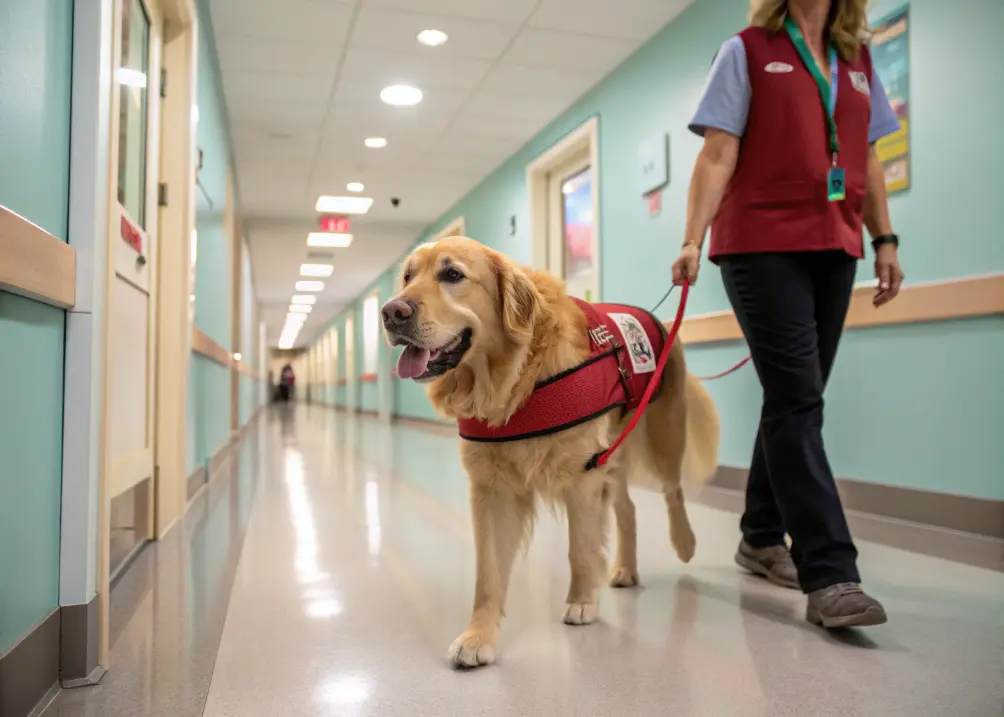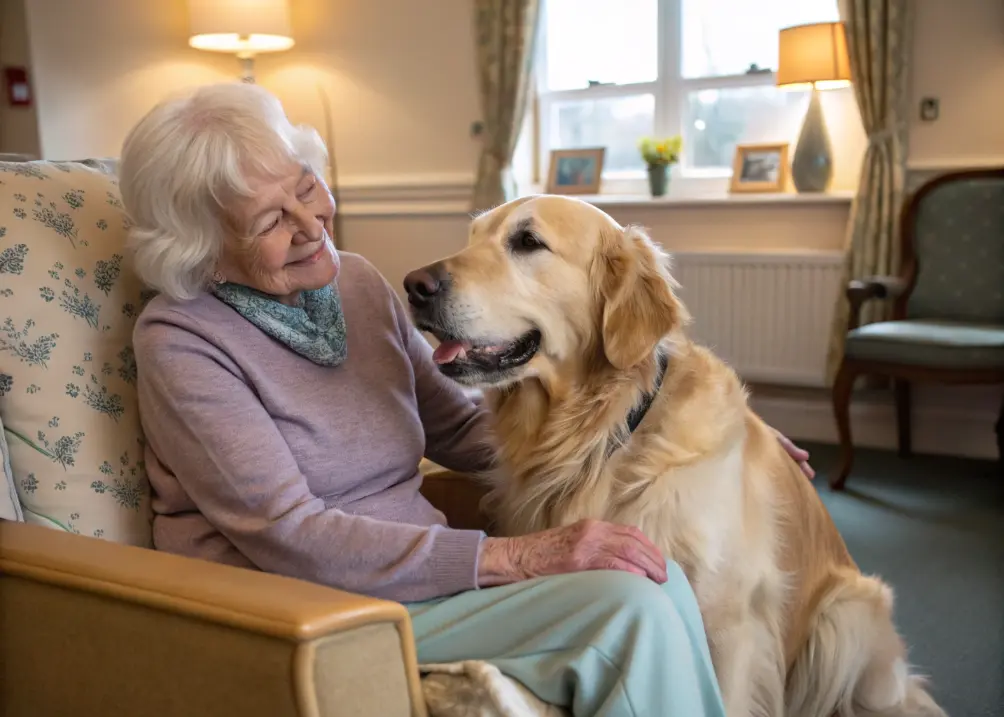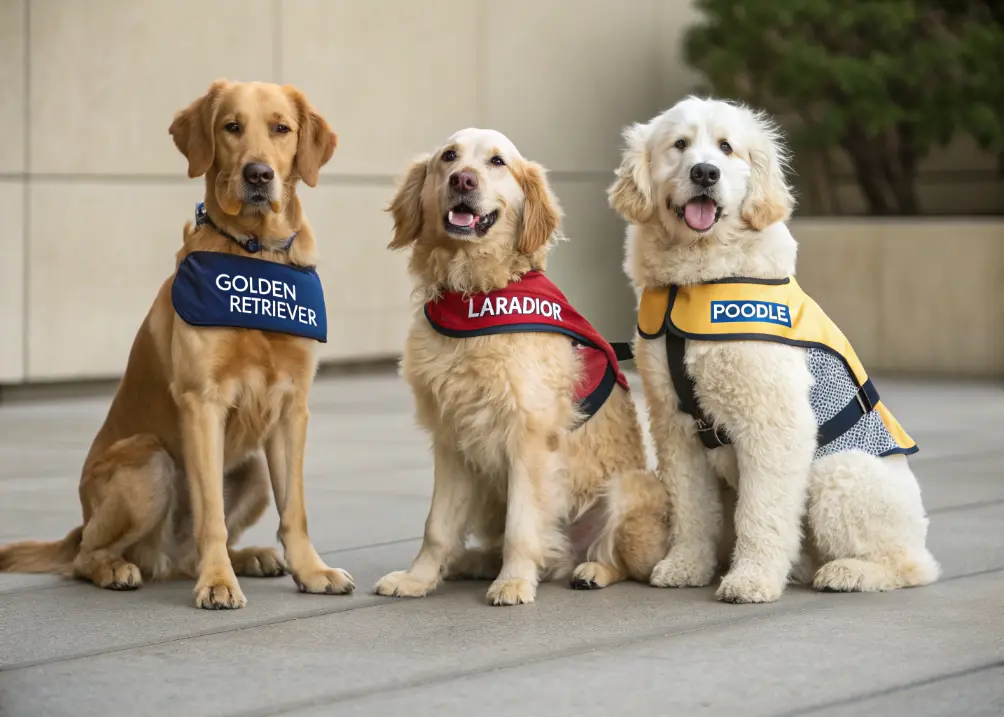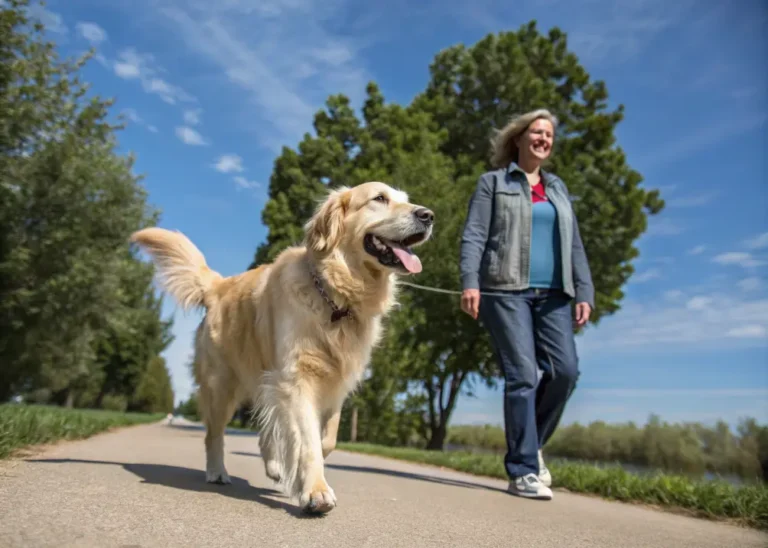Golden Retrievers as Therapy Dogs: Healing with Four Paws
Golden Retrievers are more than just those goofy, tail-wagging, tennis-ball-chasing dogs we all know and love. Sure, they’ll steal your socks, shed like crazy, and beg for snacks at the dinner table — but behind all that golden fluff, they have this incredible gift: the ability to comfort people in ways words can’t.
If you’ve ever been around a Golden, you know what I mean. They have this warm, calm energy that just melts away stress. That’s why Golden Retrievers are one of the most popular breeds used as therapy dogs. They walk into hospitals, nursing homes, schools, even disaster zones, and somehow make everything feel a little lighter.
But why Goldens? What makes them so good at this? And what does science say about the healing power of therapy dogs? Let’s dig in.

1. What Is a Therapy Dog, Anyway?
A lot of people mix up therapy dogs with service dogs or even emotional support animals — but they’re not all the same.
- Service dogs are trained to do specific tasks for people with disabilities (like guiding someone who’s blind or alerting to seizures).
- Emotional support animals (ESAs) are pets that give comfort just by being there, but they don’t need special training.
- Therapy dogs (like Golden Retrievers in this case) are trained to provide comfort and affection to lots of people in settings like hospitals, nursing homes, schools, or after crises.
According to the Alliance of Therapy Dogs, there are thousands of registered therapy dogs across the U.S., and Golden Retrievers are always near the top of the list. They just seem built for the job.

2. Why Golden Retrievers Are Natural Therapy Dogs
Some breeds are naturally better at therapy work, and Golden Retrievers are one of them. Here’s why:
- Gentle and patient – Goldens rarely lose their cool, even in chaotic places like busy hospitals.
- Friendly with everyone – They don’t really meet strangers, only friends they haven’t licked yet.
- Trainable – Ranked the 4th smartest breed by dog psychologist Stanley Coren, they’re quick learners.
- Non-threatening appearance – Big brown eyes, floppy ears, fluffy tails… let’s be honest, they look like walking comfort pillows.
I once saw a therapy Golden in a children’s cancer ward. He wasn’t doing anything fancy — just lying there while kids leaned on him, petting his fur. But the room felt completely different, softer somehow. That’s the kind of magic Goldens bring.

3. The Science Behind Dogs and Healing
It’s not just “aww, cute dog makes people smile.” Research shows real health benefits.
- A study in Frontiers in Psychology (2020) found therapy dogs reduce cortisol (the stress hormone) and boost oxytocin (the bonding hormone).
- The NIH reports that petting a dog for even a few minutes lowers blood pressure and heart rate.
- In BMC Psychiatry, animal-assisted therapy was linked to reduced depression and anxiety symptoms in patients.
In other words: science agrees that Golden Retrievers really can heal with four paws, a wagging tail, and maybe a slobbery kiss or two.

4. Where Golden Retrievers Do Their Therapy Work
Therapy Goldens show up in all sorts of places:
- Hospitals – Comforting patients before surgery, or visiting kids stuck in long-term care.
- Nursing Homes – Helping seniors feel less lonely and even stimulating memory in dementia patients.
- Schools & Libraries – Kids read to therapy dogs to gain confidence, since a dog won’t laugh at mispronunciations.
- Disaster Zones – After hurricanes, school shootings, or other crises, therapy dogs provide emotional relief.
Fun fact: after the 9/11 attacks, dozens of Golden Retrievers were part of the comfort dog teams that helped rescue workers and grieving families. They weren’t searching for survivors — they were simply there to sit, snuggle, and absorb some of the pain.

5. How to Train a Golden Retriever for Therapy Work
Not every Golden is automatically ready to be a therapy dog. They need training and certification.
Steps usually include:
- Basic obedience training – Sit, stay, down, come. No jumping on people or stealing snacks off tables.
- Socialization – Expose them to crowds, wheelchairs, loud sounds, kids, and different environments.
- Canine Good Citizen (CGC) test – Many therapy programs require this AKC certification.
- Therapy program evaluation – Organizations like Pet Partners or Alliance of Therapy Dogs test dogs for temperament and manners.
The process can take months, but it’s worth it if your Golden has the right personality — calm, loving, and able to handle chaos without stress.

6. Amazing Stories of Golden Retrievers Healing Hearts
There are countless stories of Goldens working miracles, but here are a few that always stick with me:
- Tucker the PTSD helper – In Ohio, a Golden named Tucker visits veterans with PTSD. Soldiers reported better sleep and reduced anxiety after therapy sessions with him.
- Ruthie Comfort Dog – Part of the Lutheran Church Charities K-9 Comfort Dog team, Ruthie visited schools after tragedies. Teachers said she helped kids feel safe enough to talk about their feelings.
- Everyday heroes – Even without vests or titles, many Goldens act like therapy dogs at home, sitting quietly with crying teenagers or nudging owners out of panic attacks.
That’s the thing — Goldens don’t need to be “certified” to comfort. It’s who they are.

7. Challenges of Therapy Dog Work
Of course, therapy work isn’t always easy.
- Dogs can get overstimulated in loud, emotional environments.
- Cleanliness is a must — regular grooming, baths, and trimmed nails.
- Not everyone likes dogs (allergies or fears).
- Emotionally draining — handlers say seeing pain and grief can affect both human and dog.
That’s why rest days are super important. Even the most loving Golden needs downtime to recharge.

8. Why Goldens Stand Out Among Therapy Breeds
Labradors, Poodles, and even mixed breeds also make amazing therapy dogs. But Goldens stand out because of their unique combo: goofy enough to make you laugh, gentle enough to calm your nerves, and smart enough to know when to just sit quietly.
According to the AKC, Golden Retrievers consistently rank in the top 5 for therapy work worldwide. Their mix of size, softness, and personality just clicks with people across all ages.

9. The Future of Therapy Goldens
The demand for therapy dogs is growing. Schools, hospitals, and workplaces are recognizing the benefits of canine comfort. With mental health awareness on the rise, Goldens will continue to be at the center of therapy work.
There’s also ongoing research — the Human-Animal Bond Research Institute (HABRI) is funding studies on how therapy dogs impact everything from PTSD recovery to classroom learning. Spoiler: results are super positive.

FAQs About Golden Retrievers as Therapy Dogs
1. What’s the difference between a therapy dog and a service dog?
Service dogs do specific tasks for one person’s disability. Therapy dogs comfort groups of people in public places.
2. Are Golden Retrievers the best breed for therapy work?
They’re one of the best, along with Labs, Poodles, and mixed breeds.
3. Can any Golden become a therapy dog?
Not all. They need a calm, friendly temperament and structured training.
4. How old should a Golden be before therapy training?
Most programs require at least 1 year old, but basic socialization starts as a puppy.
5. Do therapy dogs get paid?
Usually no. Most handlers volunteer, though some programs reimburse costs.
6. Can therapy dogs help with PTSD?
Yes, studies show therapy dogs reduce PTSD symptoms and improve sleep and social functioning.
7. Do therapy dogs have public access rights like service dogs?
No. They only visit places where they’re invited, like hospitals or schools.
8. How long can a Golden work as a therapy dog?
Many retire around 8–10 years old, depending on health and energy.
9. How do therapy dogs help children in schools?
Programs like “Read to a Dog” improve literacy and reduce test anxiety.
10. Do Goldens enjoy therapy work?
The right Golden loves it — but handlers must watch for stress signals.

References
- Alliance of Therapy Dogs – https://www.therapydogs.com
- American Kennel Club, Canine Good Citizen Program – https://www.akc.org
- Frontiers in Psychology, “Effects of Animal-Assisted Therapy on Stress Hormones” (2020)
- BMC Psychiatry, “Animal-Assisted Therapy in Mental Health Treatment”
- National Institutes of Health (NIH), Pet Ownership & Health Benefits
- Human-Animal Bond Research Institute (HABRI) – https://habri.org
we have many helpful blog post about Golden Retriever, you might want to check them out.
How Long Do Golden Retrievers Really Live?
The Funny Golden Retrievers Nobody Talks About
Black Cat And Golden Retriever Friendship






